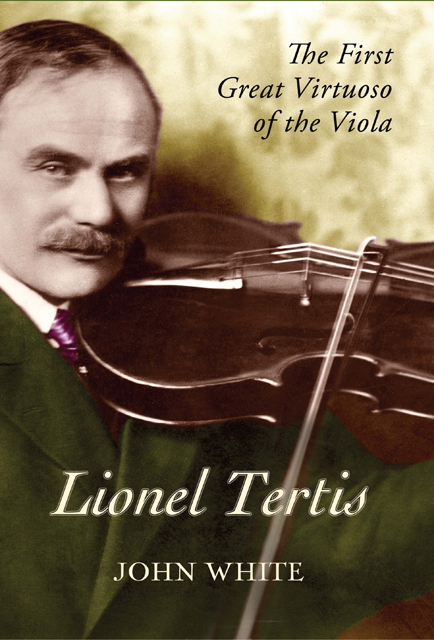Book contents
- Frontmatter
- Dedication
- Contents
- List of illustrations
- Foreword
- Preface
- Acknowledgements
- 1 The Tertis Family
- 2 Early Career
- 3 The Great War
- 4 The Chamber Music Players
- 5 American Tours
- 6 Return to the Royal Academy of Music
- 7 The Elgar and Walton Concertos
- 8 The BBC Orchestra, Delius, Bax and Vaughan Williams
- 9 A Shock Retirement
- 10 The Richardson–Tertis Viola
- 11 The Second World War
- 12 Promoting the Tertis Model Viola
- 13 Return to America and Eightieth Birthday Celebrations
- 14 Second Marriage and Last Appearance
- 15 TV Profile and Ninetieth Birthday
- 16 Final Years
- Notes
- Appendix 1 Tertis’s Violas
- Appendix 2 The Tertis Model Viola
- Appendix 3 Tertis’s Writings and Talks
- Appendix 4 Tertis’s BBC Appearances
- Appendix 5 Tertis’s Honours
- Appendix 6 Music with Tertis Connections
- Appendix 7 The Tertis Bequest
- Appendix 8 The Tertis Legacy
- Discography
- Bibliography
- Index
15 - TV Profile and Ninetieth Birthday
Published online by Cambridge University Press: 18 March 2023
- Frontmatter
- Dedication
- Contents
- List of illustrations
- Foreword
- Preface
- Acknowledgements
- 1 The Tertis Family
- 2 Early Career
- 3 The Great War
- 4 The Chamber Music Players
- 5 American Tours
- 6 Return to the Royal Academy of Music
- 7 The Elgar and Walton Concertos
- 8 The BBC Orchestra, Delius, Bax and Vaughan Williams
- 9 A Shock Retirement
- 10 The Richardson–Tertis Viola
- 11 The Second World War
- 12 Promoting the Tertis Model Viola
- 13 Return to America and Eightieth Birthday Celebrations
- 14 Second Marriage and Last Appearance
- 15 TV Profile and Ninetieth Birthday
- 16 Final Years
- Notes
- Appendix 1 Tertis’s Violas
- Appendix 2 The Tertis Model Viola
- Appendix 3 Tertis’s Writings and Talks
- Appendix 4 Tertis’s BBC Appearances
- Appendix 5 Tertis’s Honours
- Appendix 6 Music with Tertis Connections
- Appendix 7 The Tertis Bequest
- Appendix 8 The Tertis Legacy
- Discography
- Bibliography
- Index
Summary
Orchestral Seating Plan – TV Profile – 90th birthday
Lionel Tertis's restless mind was forever evolving solutions to musical problems – usually concerning sound and tone quality, which was one of his lifelong obsessions. In the early 1960s he returned to a scheme he had devised forty years earlier, for what he deemed to be the ideal orchestral seating plan. His goal was to improve the blend and balance between the different sections within the ensemble.
One of his acoustic discoveries had arisen from the supposedly primitive preelectric method of making recordings. When he had to play into the recording horn in the Aeolian-Vocalion studios, Tertis found there was a considerable difference in the tone quality of the disc when he played in different positions. The result was much more convincing when he played with the scroll directly facing the horn, than when he held the viola in the usual position at right angles to the horn. He also noticed that when a solo violinist or violist playing a concerto with orchestra faced the audience at right angles (the acceptable way), the tone was not as convincing as when he played with the scroll directly facing the audience. His other observation regarding the accepted method of seating the string players in an orchestra was that the sound holes (f holes) of the instruments faced in many different directions on a concert platform. Tertis's idea was that generally there would be a better tone, blend and balance throughout the orchestra if all, or nearly all, the string players faced the public with their instruments.
At the Free Trade Hall, Manchester, on 2 May 1964 Sir John Barbirolli gave the Tertis seating plan a trial. Tertis's idea was that the orchestra should play short excerpts from the repertoire, in the old and new seating positions. Owing to a misunderstanding, the occasion was advertised as an invitation concert in which Berlioz's Roman Carnival Overture and the tone poem Don Juan were played, first in Tertis's seating plan and then, after the interval, in the more conventional manner; according to Tertis, this ‘made it impossible to form an adequate judgement owing to the long interval between the two seating arrangements’. Differing opinions appeared in the press. Michael Kennedy of the Daily Telegraph felt that ‘with modification Mr Tertis's ideas certainly seem to be worth consideration’.
- Type
- Chapter
- Information
- Lionel TertisThe First Great Virtuoso of the Viola, pp. 274 - 283Publisher: Boydell & BrewerPrint publication year: 2006



